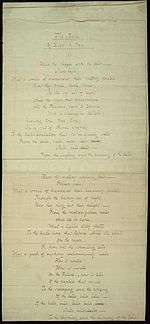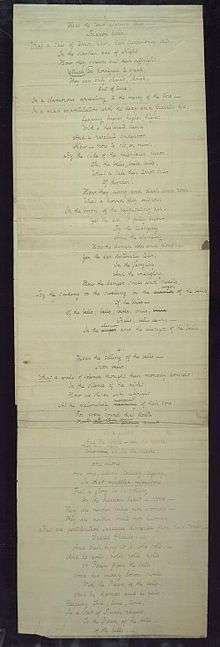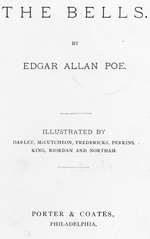The Bells (poem)


"The Bells" is a heavily onomatopoeic poem by Edgar Allan Poe which was not published until after his death in 1849. It is perhaps best known for the diacopic use of the word "bells." The poem has four parts to it; each part becomes darker and darker as the poem progresses from "the jingling and the tinkling" of the bells in part 1 to the "moaning and the groaning" of the bells in part 4.
Analysis
This poem can be interpreted in many different ways, the most basic of which is simply a reflection of the sounds that bells can make, and the emotions evoked from that sound. For example, "From the bells bells bells bells/Bells bells bells!" brings to mind the clamoring of myriad church bells. Several deeper interpretations exist as well. One is that the poem is a representation of life from the nimbleness of youth to the pain of age. Growing despair is emphasized alongside the growing frenzy in the tone of the poem.[1] Another is the passing of the seasons, from spring to winter. The passing of the seasons is often used as a metaphor for life itself. The poem also suggests a Poe theme of mourning over a lost wife, courted in sledge, married and then killed in a fire as the husband looks on. The tolling of the iron bells reflects the final madness of the grief-stricken husband.
The sounds of the verses, specifically the repetitive "bells, bells, bells, bells, bells, bells, bells," lie on a narrow line between sense and nonsense, causing a feeling of instability.[2] Poe uses the word "tintinnabulation", apparently a coinage of his own, based on the Latin word for "bell", tintinnabulum.[3] The series of "bells" echo the imagined sounds of the various bells, from the silver bells following the klip-klop of the horses, to the "dong, ding-dong" of the swinging golden and iron bells, to screeching "whee-aaah" of the brazen bells. The series are always four, followed by three, always beginning and ending on a stressed syllable. The meter changes to iambic in the lines with repeated "bells," bringing the reader into their rhythm. Most of the poem is a more hurried trochaic tetrameter.[4]
The bells of which he writes are thought to be those he heard from Fordham University's bell tower, since Poe resided in the same neighborhood as that university. He also frequently strolled about Fordham's campus conversing with both the students and the Jesuits.
Critical response
According to Poe biographer Jeffrey Meyers, "The Bells" is often criticized for being mechanical and forced.[5]
Publication history

Poe is believed to have written "The Bells" in May 1848 and submitted it three times to Sartain's Union Magazine, a magazine run by John Sartain, until it was finally accepted.[6] He was paid fifteen dollars for his work, though it was not published until after his death in the November 1849 issue. It was also published in the New York Tribune on the front page of its October 20, 1849 issue as "Poe's Last Poem".
Inspiration for the poem is often granted to Marie Louise Shew, a woman who had helped care for Poe's wife Virginia as she lay dying.[6] One day, as Shew was visiting Poe at his cottage in Fordham, New York, Poe needed to write a poem but had no inspiration. Shew allegedly heard ringing bells from afar and playfully suggested to start there, possibly even writing the first line of each stanza.[7]
Adaptations
Sergei Rachmaninoff (1873–1943) composed a choral symphony The Bells, Op. 35, based on a Russian adaptation of the poem by Konstantin Balmont. The symphony follows classical sonata form: first movement, slow movement, scherzo, and finale, thus honoring the poem's four sections.[8] (The work is sometimes performed in English, using not Poe's original, but a translation of Balmont's adaptation by Fanny S. Copeland.) The Scottish composer Hugh S. Roberton (1874–1947) published "Hear the Tolling of the Bells" (1909), "The Sledge Bells" (1909), and "Hear the Sledges with the Bells" (1919) based on Poe's poem.[9] Josef Holbrooke composed his "The Bells, Prelude, Op. 50" on Poe's poem, and American folksinger Phil Ochs composed a tune to the poem recorded on his album All the News That's Fit to Sing.
Eric Woolfson, musical partner to Alan Parsons in the Alan Parsons Project, has written two albums based on the writings of Poe. His second, Poe: More Tales of Mystery and Imagination includes a song entitled "The Bells", for which he set Poe's words to music. This album was also the basis for a musical stage production that was performed in England, Austria, and other European countries. Pink Floyd have referenced the poem in the last verse of their song "Time" on the album The Dark Side of the Moon (1973). In 1993 Danish composer Poul Ruders wrote a piece "The Bells" for high soprano and ten instruments, using Poe's text in its entirety although in Dutch.[10] The piece was premiered in London, and has appeared on a CD from Bridge Records, New York. MC Lars, a Nerdcore Hip hop musician sang a complete version of the poem on his 2012 Edgar Allan Poe EP titled "(Rock) The Bells". The song may be listened to freely on his Bandcamp page.[11]
References
- ↑ Silverman, Kenneth. Edgar A. Poe: Mournful and Never-ending Remembrance. New York City: Harper Perennial, 1991. ISBN 0-06-092331-8 p. 403
- ↑ Rosenheim, Shawn James. The Cryptographic Imagination: Secret Writing from Edgar Poe to the Internet. The Johns Hopkins University Press, 1997. p. 125. ISBN 978-0-8018-5332-6
- ↑ tintinnabulation, Oxford English Dictionary, Second edition, 1989; online version, December 2011; accessed 09 January 2012. Earlier version first published in New English Dictionary, 1912.
- ↑ http://www.shmoop.com/bells-poe/rhyme-form-meter.html
- ↑ Meyers, Jeffrey. Edgar Allan Poe: His Life and Legacy. Cooper Square Press, 1992. p. 223. ISBN 0-8154-1038-7
- 1 2 Sova, Dawn B. Edgar Allan Poe: A to Z. New York: Checkmark Books, 2001. p. 25. ISBN 0-8160-4161-X
- ↑ E. A. Poe Society of Baltimore
- ↑ AmericanSymphony.org
- ↑ Sova, Dawn B. Edgar Allan Poe: A to Z. New York: Checkmark Books, 2001. p. 212. ISBN 0-8160-4161-X
- ↑ The New Danes [Streaming Audio]. (n.d.). Bridge. Retrieved October 5, 2014, from Music Online: Classical Music Library.
- ↑ http://mclars.com/site/lyrics/edgar-allan-poe-ep
External links
-
 Works related to The Bells at Wikisource
Works related to The Bells at Wikisource - Scans from an 1881 edition with engraved illustrations by R. Riodan, Charles P. King, F.O.C. Darley, S. G. McCutcheon, A. Fredericks, and Granville Perkins
- The Bells with audio reading
-
 The Bells public domain audiobook at LibriVox
The Bells public domain audiobook at LibriVox